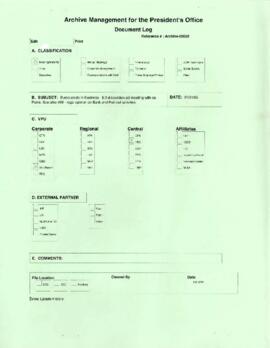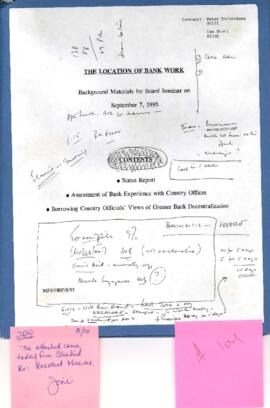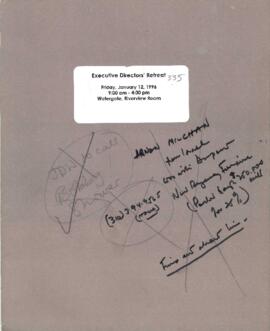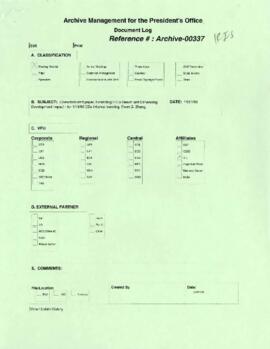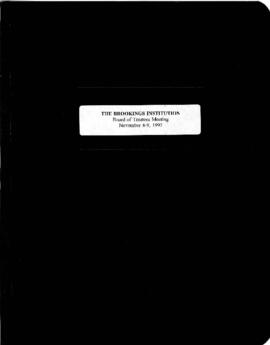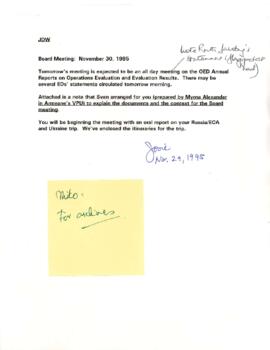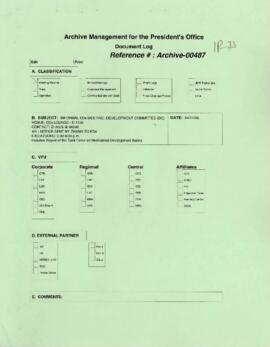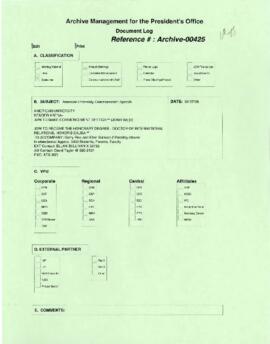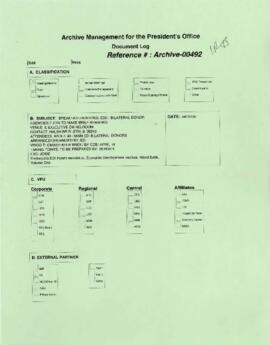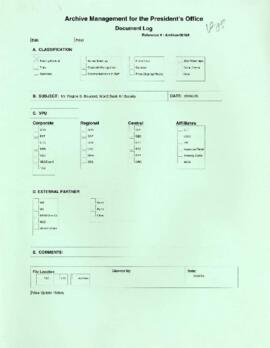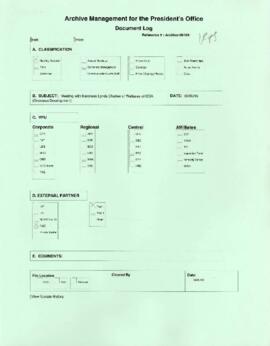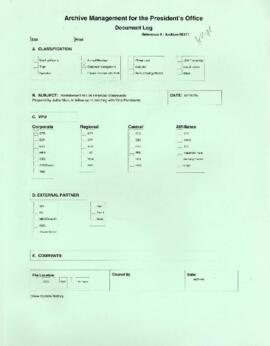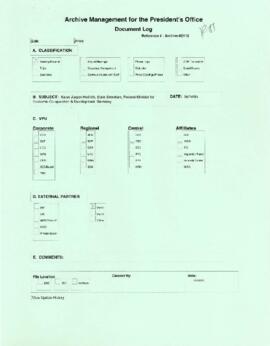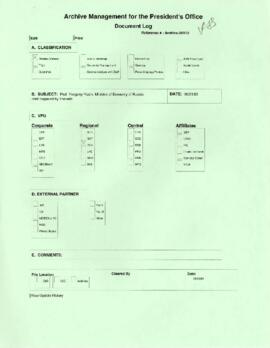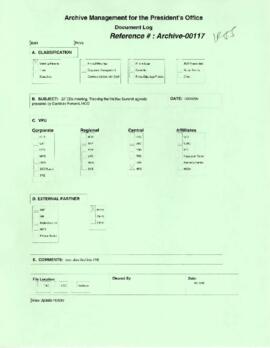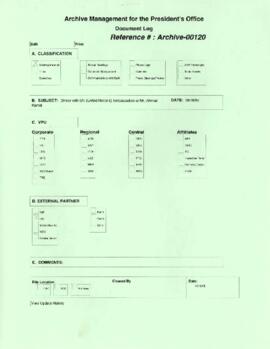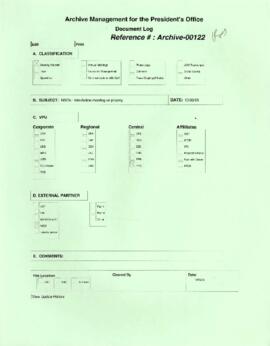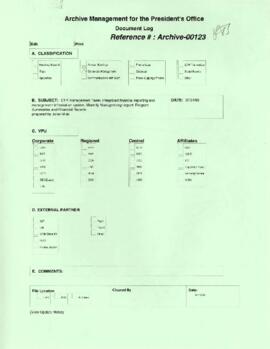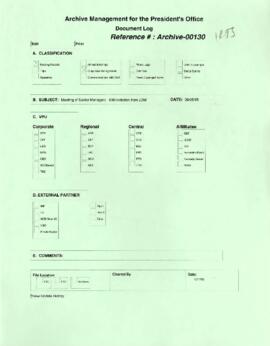Identity area
Reference code
Title
Date(s)
- 1963 - 2005 (predominant 1995 - 2005) (Creation)
Level of description
Subfonds
Extent and medium
953.46 linear feet of textual materials; 32.25 linear feet of photographs and negatives; 370 videocassettes; 99 audiocassettes; 18 DVDs; 15 video CDs; 5 audio CDs; 4 photo CDs; 1 floppy disk
Context area
Name of creator
Biographical history
James David Wolfensohn was named the World Bank Group's ninth president on March 16, 1995; he officially took office on June 1, 1995. Wolfensohn, who was born in Sydney, Australia in 1933 but became a naturalized U.S. citizen in 1980, led a varied and accomplished life prior to joining the Bank Group. After moving to America in 1959 to attend Harvard Business School, he was employed by a series of firms and investments banks in Sydney, London, and New York before creating his own investment firm in New York in 1981. An accomplished athlete (he was a member of Australia's 1956 Olympic fencing team), he also had a passion for the arts, serving as chairman of New York's Carnegie Hall (1980-1991) and the John F. Kennedy Center for the Performing Arts in Washington, DC (1990-1995).
Wolfensohn and Bank Operations
Wolfensohn arrived at the World Bank Group (WBG) during a period when the institution was under intense scrutiny. Upon his arrival, the institution was facing questions from both governments and nongovernmental organizations (NGOs) about debt, project effectiveness, corruption, the Bank Groups' budget, and the impact of its projects on the environment. Protests had taken place at the WBG/International Monetary Fund's (IMF) Annual Meetings the previous year and questions about the institution's continued effectiveness and relevance were being openly discussed.
While Wolfensohn's efforts to revitalize the Bank Group were wide-ranging, his immediate and overarching priority was to refocus the institution on poverty. Over the previous 15 years, the Bank Group had increasingly emphasized governance and financial policy reforms (expressed most prominently in an increasing reliance on structural adjustment loans [SALs]) as the most important tool for economic growth in developing countries. Wolfensohn's immediate objective was to reorient the Bank Group's efforts towards poverty alleviation through projects and other initiatives that would most directly and efficiently impact the world's poorest.
To this end, debt relief was identified as the most urgent issue. Wolfensohn used his first address to the WBG and IMF Board of Governors at the 1995 Annual Meetings to discuss the impact of high levels of debt on member countries and the limits it imposed on their capacity for economic growth. The following year, the WBG and the IMF, with the support of NGOs and wealthier member governments, joined forces to launch the Debt Initiative for Heavily Indebted Poor Countries (HIPC). HIPC initially allocated $500 million for a debt relief trust fund that affected about thirty member countries. The initiative would be enhanced and expanded in 1999.
Wolfensohn subsequently turned his attention to transparency and accountability in Bank Group operations and the use of its funds by member countries. In his speech at the 1996 Annual Meetings, he famously addressed the "cancer of corruption" prevalent in the finances of many developing countries, describing it as "a major barrier to sound and equitable development." The Bank Group offered its assistance to governments to implement national programs to discourage corrupt practices and set up an internal task force, the Corruption Action Plan Working Group, to develop a systematic framework for addressing corruption as a development issue. At Wolfensohn's urging, the Bank Group's Board of Executive Directors formally approved an anti-corruption strategy in September 1997. A number of other initiatives were undertaken and reports published over the next decade that would maintain focus on corruption. The first Annual Report on Investigations and Sanctions of Staff Misconduct and Fraud and Corruption in Bank-Financed Projects was published in February 2005.
In 1997, Wolfensohn and his staff introduced the "Strategic Compact", an institutional renewal effort focused on the administration, organization, and operations of the World Bank Group. The initiative was intended to help theinstitution respond faster and more effectively to client needs and development opportunities. Initially communicated by Wolfensohn to Bank Group staff in a January 1997 memo, the Board of Executive Directors agreed to fund the compact at $250 million over three years beginning in April 1997.
The compact had four main programs: to provide better services to the Bank Group's clients; to refocus the development agenda to include greater attention to human development, environment and institutions; to provide better knowledge management; and to overhaul the institution's operations by cutting back management and decentralizing functions and responsibilities to the field. The compact included funding to support the continuation and expansion of a Bank-wide reorganization that had already begun in 1996. The reorganization involved the creation of smaller Country Management Units (CMUs) to replace the existing Country Departments while accelerating decentralization of CMU staff and country directors to locationsin client countries. Funding for the compact was also used for investment in technology enhancement and staff training.
This decentralization of staff and decision-making was a primary feature of the compact. By the end of the compact's implementation period, the Bank's Operations Evaluation Department (OED) report titled Assessment of the Strategic Compact reported that the number of country directors located outside Washington, DC had risen from 3 in FY97 to 29 in FY02 and that functions carried out in the country offices had expanded in areas such as project supervision, procurement, and financial management. The number of staff stationed in client countries increased from 1700 in 1995 to 4500 when Wolfensohn ended his second term as president in 2005.
Arguably the most ambitious reorientation of the Bank Group's approach to supporting the economic development of member countries was launched in 1999. The Comprehensive Development Framework (CDF) was introduced to Board members and some senior staff in January 1999, endorsed by the Board on March 11, 1999, and piloted by Bolivia, beginning in June of the same year. The framework was based on four interdependent principles: a long-term holistic vision of development; country ownership of the development strategy; ensuring that development assistance is a country-led partnership; and a focus on results. A key element inthe introduction of the CDF was encouraging member country governments to develop a long-term vision for the country's economic development by authoring a Poverty Reduction Strategy Paper (PRSP), a review of its macroeconomic, structural, and social policies and programs over a three-year or longer horizon.
Wolfensohn's tenure was also notable in that the institution, under Wolfensohn's direction and example, increasingly engaged with external entities, including civil society and NGOs. Much of the criticism directed towards the WBG in the years prior to Wolfensohn's arrival had been leveled by these increasingly vocal and influential groups. From the onset of his presidency and throughout his ten years leading the Bank Group, Wolfensohn met with and, to a degree unprecedented in the history of the institution, involved these outside voices. Wolfensohn also developed strong relationships with other multilateral organizations, including IMF, United Nations (UN), and World Trade Organization (WTO), as well asleaders in the corporate world.
During his decade at the World Bank Group, Wolfensohn directed an impressive program of varied approaches to poverty alleviation. His tenure at the institution was characterized by a more holistic conception of development and an expansive approach to how the institution could support developing countries. Some of the more prominent of these initiatives included:
-
Reconstruction - The Bank Group returned to the institution's original focus of support for countries following conflict and natural disasters. Instead of waiting for the UN and other aid agencies to address the most urgent needs of countries in distress before providing support, the Bank Group under Wolfensohn became involved much sooner. Examples of Bank Group lending for reconstruction include the Balkans, Timor-Leste, Afghanistan, and Iraq following military conflict and Indonesia following the December 2004 tsunami.
-
HIV/AIDS - While the Bank Group had been involved in HIV/AIDS funding since the late 1980s, during Wolfensohn's tenure it intensified its fight against the virus while working in collaboration with other organizations. In the fall of 1999, the Bank Group launched an HIV/AIDS strategic plan and in January 2000, Wolfensohn spoke on the issue to the UN Security Council, focusing in particular on the virus's devastating impact on Africa's people and its development prospects.
-
Environment - During Wolfensohn's terms as president the Bank Group adopted its first comprehensive strategy for the environment and development and launched a fund for reducing greenhouse gas emissions.
-
Marginalized people - Wolfensohn identified marginalized communities, including the Roma, youth, and people with disabilities, for potential Bank Group support. In June 2002, the Bank Group hired Judith Heumann to serve as the institution's first Disability Adviser.
-
Other themes and initiatives introduced or emphasized by the Bank Group under Wolfensohn's leadership include: utilizing technology in Bank Group project design and implementation; outreach to the private sector and development of micro-credit facilities; gender inclusivity with respect to Bank Group operations and staffing; support for the cultural heritage sector in developing countries; and establishing the role of the World Bank Group as a development knowledge hub.
By the end of his two terms as president of the World Bank Group, Wolfensohn had become the most traveled of Bank Group presidents. From the beginning of his tenure, he prioritized developing relationships with Bank Group clients and first-hand review of the projects it funded. Within 15 daysof joining the Bank Group, Wolfensohn left for his first overseas trip, visiting five countries in the African Sahara. By the end of his time at the Bank Group, he had visited over 120 countries.
In March 2005, Wolfensohn announced that he would not seek a third term as president of the World Bank Group. Wolfensohn left the Bank Group on May 31, 2005, becoming only the third World Bank Group president to serve two terms.
Organization of the Office of the President
The Office of the President (EXC) provides support to the WBG president who: is responsible for the overall management of the WBG; represents the WBG to the world at large; formulates policies and programs for approval by the Board of Executive Directors, and; more generally, carries out the purposes of the institution in accordance with the Articles of Agreement and the wishes of its shareholders. The Office of the President maintains information on the president's speeches, interviews, and travels and manages and allocates funds within the office via the budgeting function.
The organization of the Office of the President was relatively consistent throughout President Wolfensohn's tenure as WBG president. It consisted of a Front Office, Middle Office, Budgeting Office, Correspondence Unit, and a Scheduling Unit.
The Front Office supported the WBG president by managing aspects related to correspondence, communication, and travel. Specifically, it:
-
Managed correspondence by mail, email, and fax;
-
Maintained a rolodex of contact information;
-
Created and maintained a daily telephone log book;
-
Arranged all travel logistics and partially maintained a travel schedule in cooperation with the Middle Office and the Scheduling Unit;
-
Assisted in ad hoc personal projects and aspects of the president's life.
The Middle Office was led by the president's chief of staff. The Middle Office managed and advised the president on all matters related to trips, meetings, speeches, and relationships with outside partners, affiliate institutions,member governments, and vice presidential units. The office's functions specifically included:
-
Management of the president's travel, external meetings and appearances. This included confirming trip dates, planning trips, and planning briefing books and pre-trip briefings;
-
Support of the president's speeches and press conferences, including speechwriting, and planning speeches and other appearances;
-
Receiving and managing photographs, press clippings, and other memorabilia.
The Budgeting Office allocated and reported on funds used for EXC activities and received and reviewed requests and progress reports for the president's Contingency Funds and Ideas Fund for Simplification.
The Correspondence Unit managed the in/out of EXC correspondence, averaging between 8,000 and 10,000 pieces of correspondence annually. This involved: managing EnCorr, the database registry system, to log the correspondence; sending correspondence to assignees (vice presidencies or managing directors) to assign or prepare a response; conducting audits of the EnCorr system to identify overdue correspondence; and making regular transfers of correspondence to the WBG Archives.
The Scheduling Unit was responsible for managing President Wolfensohn's briefings and appearances, including receiving requests for meetings and internal speaking engagements, negotiating date and time of the events, and issuing event/meeting confirmation notices. The unit also managed the president's official calendar, using the personal information software system, ECCO.
Managing Directors and Advisers
When he arrived in 1995, Wolfensohn inherited the senior management organization implemented by his predecessor, Lewis Preston. This consisted of three managing directors (MD) that reported directly to Wolfensohn. Each MD was responsible for a group of areas and each vice president that was responsible for one of those areas reported to that MD.
In addition to the MDs, the senior vice president and general counsel (LEGVP) and the senior vice president and chief economist (DECVP) also reported to the president. The vice president, External Affairs (EXTVP) had a dual-reporting relationship to the president and to one of the MDs.
The following managing directors served during Wolfensohn's tenure as World Bank Group president:
-
Sven Sandstrom (December 1991 - December 2001; appointed during Lewis Preston's presidency): Initially, led human and information resources and management services. In January 1999, he was given leadership over finance and resource mobilization. He would also provide overall guidance for the International Development Association (IDA) and HIPC.
-
Richard H. Frank (February 1995 - July 1997; appointed during Lewis Preston's presidency): In charge of the Bank Group's private sector development strategy.
-
Gautam S. Kaji (December 1994 - December 1997; appointed during Lewis Preston's presidency): Responsible for the Bank Group's operations, policies, and programs.
-
Caio Koch-Weser (January 1996 - April 1999): Responsible for the Bank Group's operations, policies, and programs.
-
Jessica Einhorn (January 1996 -August 1998): The WBG's first woman MD, Einhorn was responsible for finance and resource mobilization.
-
Shengman Zhang - (December 1997 - January 2006): Elevated from vice president and corporate secretary (SEC) to managing director and corporate secretary. In addition to the Bank Group's corporate secretary, he also oversaw Human Resources (HR), Information Solutions Group (ISG), General Services Department (GSD), the Internal Audit Department (IAD), Inspection Panel, and Administrative Tribunal. In October 2001, Zhang was asked to lead regional operations and relationships with other multilateral development banks (MDBs).
-
Peter Woicke (January 1999 - January 2005): Managing director and executive vice president of the International Finance Corporation (IFC).
-
Jeffrey Goldstein (September 1999 - October 2004): Responsible for internal and external affairs and liaison with client governments. In October 2001, became responsible for the Bank Group's banking and finance sectors and directing the institution's finance and resource mobilization activities. He was also given oversight of the Poverty Reduction and Economic Management (PREM) Network. In May 2003 he was named chief financial officer in addition to his role as MD.
-
Mamphela Ramphele (January 2001 - June 2004): Oversaw the Bank's activities in health, education, and social protection. In October 2001, the external relations portfolio was given to Ramphele. After relinquishing her duties as MD in June 2004, Ramphele remained at the Bank in the role of senior adviser to the president.
Repository
Archival history
Immediate source of acquisition or transfer
Records in this subfonds were transferred from the creating office to the World Bank Group Archives according to approved records retention and disposition schedules (RRDS).
Content and structure area
Scope and content
The subfonds contains correspondence between President Wolfensohn and both internal and external parties as well as briefing materials authored by the Office of the President (EXC) and other World Bank Group units in support of the president's various activities. Audio-visual documentation of his travel and participation in internal and public events is also included as are records relating to the scheduling of the president's daily activities. Records relating to the president's advisers are also arranged in this subfonds. Languages used in the records have been included at the series level to the extent possible but is not exhaustive as a full review of all the records in this subfonds has not been undertaken.
Appraisal, destruction and scheduling
Accruals
System of arrangement
Conditions of access and use area
Conditions governing access
Records are subject to the World Bank Policy on Access to Information as well as the separate access to information policies of IFC, MIGA, and ICSID, either individually or collectively.
Conditions governing reproduction
Records are subject to the Copyright Policy of the World Bank Group.
Language of material
Script of material
Language and script notes
Physical characteristics and technical requirements
Finding aids
Allied materials area
Existence and location of originals
Existence and location of copies
Related units of description
Notes area
Note
During President Wolfensohn’s tenure as World Bank Group (WBG) president, the Office of the President (EXC) implemented a hybrid recordkeeping practice, striving to maintain the records it managed in both electronic and paper format. Paper records were scanned and logged in the document management system; similarly, all born digital material, such as email, was printed off and then scanned as part of the office’s recordkeeping practice.
The office employed EnCorr, a document management system database application, used for managing and tracking documents, including the creation of document logs, document information and classification entry, action assignment and status maintenance, audit reporting, and document search. Documents were stored in IRIS, the institutional recordkeeping system. These systems initially operated separately but were integrated in 1999.
This hybrid practice was employed for most records in this subfonds, including those that have been arranged into the correspondence and briefing materials series.
Prior to the description of the records in this series, an assessment of the completeness of the electronic version of the records in this subfonds and comparison to the paper version was undertaken. It was determined that the physical collection was more complete and that, in some instances, the records’ classification appeared to have been altered since the records’ original filing. As a result, the paper records created during President Wolfensohn’s time in office have been the basis of this description and are available for public access in accordance with the applicable WBG policy.
Alternative identifier(s)
Access points
Subject access points
Place access points
Name access points
Genre access points
Description control area
Description identifier
Institution identifier
Rules and/or conventions used
Internal World Bank Group Archives rules based on ISAD(G).
Disclosure status
Level of detail
Dates of creation revision deletion
10 April 2025




